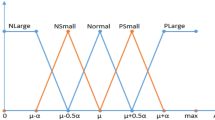Abstract
The paper introduces a novel dual-model classification method – Dual-Model Classification System (DMCS). The DMCS is a personalized or transductive system which is created for every new input vector and trained on a small number of data. These data are selected from the whole training data set and they are closest to the new vector in the input space. In the proposed DMCS, two transductive fuzzy inference models are taken as the structure functions and trained with different sub-training data sets. In this paper, DMCS is illustrated on a case study: a real medical decision support problem of estimating the survival of hemodialysis patients. This personalized modeling method can also be applied to solve other classification problems.
Preview
Unable to display preview. Download preview PDF.
Similar content being viewed by others
References
Altman, D.G.: Practical Statistics for Medical Research. Chapman and Hall, London (1991)
Donner, A., Eliasziw, M.: A goodness-of-fit approach to inference procedures for the kappa statistic: confidence interval construction, significance-testing and sample size estimation. Statistics in Medicine 11, 1511–1519 (1992)
Gammerman, A., Vovk, V., Vapnik, V.: Learning by transduction. In: Cooper, G.F., Moral, S. (eds.) Proc. of the 14th Conference on Uncertainty in Artificial Intelligence, Madison, Wisconsin, pp. 148–155. Morgan Kaufmann, San Francisco (1998)
Golub, C.L., Van Loan, C.: Matrix computations. Jons Hopkins University Press, Baltimore
Goodkin, D.A., Mapes, D.L., Held, P.J.: The dialysis outcomes and practice patterns study (DOPPS): how can we improve the care of hemodialysis patients? Seminars in Dialysis 14, 157–159 (2001)
Hsia, T.C.: System Identification: Least-Squares Methods. D.C. Heath and Company (1977)
Kukar, M.: Transductive reliability estimation for medical diagnosis. Artif. Intell. Med. 29, 81–106 (2003)
Marshall, M.R., Song, Q., Ma, T.M., MacDonell, S., Kasabov, N.: Evolving Connectionist System versus Algebraic Formulae for Prediction of Renal Function from Serum Creatinine. Kidney International 67, 1944–1954 (2005)
McKenzie, D.P., Mackinnon, A.J., Peladeau, N., Onghena, P., Bruce, P.C., Clarke, D.M., Harrigan, S., McGorry, P.D.: Comparing correlated kappas by resampling: is one level of agreement significantly different from another? Journal of Psychiatric Research 30, 483–492 (1996)
McKenzie, D.P., Mackinnon, A.J., Clarke, D.M.: KAPCOM: a program for the comparison of kappa coefficients obtained from the same sample of observations. Perceptual and Motor Skills, 899–902 (1997)
Neural Network Toolbox User’s Guide. The Math Works Inc., 3 Apple Hill Drive, Natrick, Massachusetts, Ver. 4 (2002)
Oja, E.: A simplified neuron model as a principal component analyzer. Journal of Mathematical Biology 16, 267–273 (1982)
Song, Q., Kasabov, N.: NFI: A Neuro-Fuzzy Inference Method for Transductive Reasoning. IEEE Trans. on Fuzzy Systems 13(6), 799–808 (2005)
Song, Q., Kasabov, N.: TWNFI – Transductive Neuro-Fuzzy Inference System with Weighted Data Normalization for Personalized Modelling. Neural Networks 19, 1591–1596 (2006)
Vapnik, V.: The Nature of Statistical Learning Theory. Springer, New York (1995)
Xu, L., Oja, E., Suen, C.Y.: Modified Hebbian Learning for Curve and Surface Fitting. Neural Networks 5, 441–457 (1992)
Author information
Authors and Affiliations
Editor information
Editors and Affiliations
Rights and permissions
Copyright information
© 2009 Springer-Verlag Berlin Heidelberg
About this paper
Cite this paper
Song, Q., Weng, R., Weng, F. (2009). DMCS: Dual-Model Classification System and Its Application in Medicine. In: Nicholson, A., Li, X. (eds) AI 2009: Advances in Artificial Intelligence. AI 2009. Lecture Notes in Computer Science(), vol 5866. Springer, Berlin, Heidelberg. https://doi.org/10.1007/978-3-642-10439-8_33
Download citation
DOI: https://doi.org/10.1007/978-3-642-10439-8_33
Publisher Name: Springer, Berlin, Heidelberg
Print ISBN: 978-3-642-10438-1
Online ISBN: 978-3-642-10439-8
eBook Packages: Computer ScienceComputer Science (R0)




